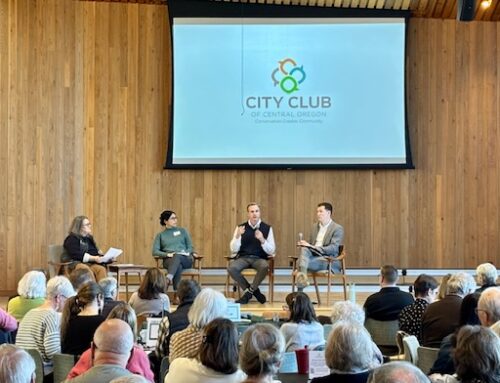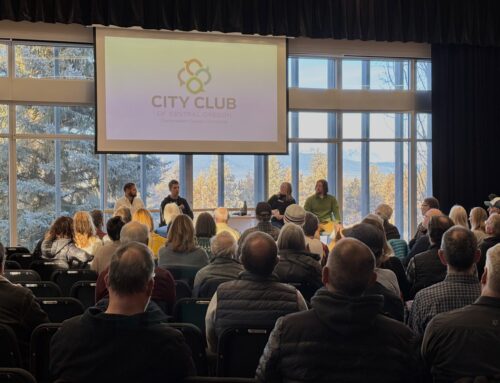Yesterday, City Club of Central Oregon hosted its March forum, “We Need to Talk about Gun Safety in Central Oregon,” in partnership with The Bulletin. The forum’s panelists unpacked the meaning of gun safety and offered advice for how to safely store and handle a gun, as well as how to have civil conversations on the polarizing issue.
Forty-six percent of participating attendees responded “yes” to the opening Menti question, “Are there firearms in your household?,” a data point on par with a 2020 survey by the RAND Corporation that estimated 50.8% of Oregon households own a gun. When asked how they define gun safety, the audience responded with 166 answers, ranging from responsible ownership and better background checks, to no guns and a ban on AR-15s.
Panelist Michelle Barnhart’s broad view of gun safety is “any and all efforts to reduce the risk of gun injury or death,” and she included efforts at the individual level, community level like the forum, and state and federal regulation. An associate professor of marketing at Oregon State University, Branhart said the vast majority of gun owners she’s spoken with as part of her research want to be, and be seen as, responsible gun owners.
“Safety is so related to responsibility, and responsibility is very tied to morality,” she said. “And the challenge comes to be that we all have different ideas about what is responsible behavior.” Someone feeling like their morality is in question, she said, can make conversations about gun safety uncomfortable.
Panelist Shannon Monihan, CEO of Red Frog Team, is focused on formal tactical firearm training, especially lowering barriers of entry for women. “Like an instrument you need to be proficient at in the musical world, a firearm is an instrument you need to be very proficient in,” she said.
The changes in firearm type, availability and usage have changed dramatically in the last 50 years, and those changes have “increased the opportunity for those firearms to get in the hands of those people who are not educated,” said Monihan. Regardless of someone’s opinion of firearms, she wants them to be capable of identifying a safe or unsafe firearm.
When considering child injury and suicide, it’s easier for someone to harm themselves with a handgun than a longarm. “Both of those risks have increased with the increase in handguns,” adds Barnhart.
“You shouldn’t have your firearms if you’re in a mental health crisis,” said panelist Dr. Torree McGowan, an emergency medicine physician at St. Charles Medical Group. “If you are thinking about harming yourself, ask someone you trust to share that firearm for you until that crisis has passed.”
Rural areas have a higher suicide rate than urban areas, said McGowan, “because people are much more likely to attempt with a firearm than with other means.” She said that suicide attempts with a firearm have an 85% success rate, and the other 15% end in lifelong disability and injury.
After table discussions, the closing Q&A in part addressed conversations about gun safety. When discussing the issue with those who hold opposing views, Monihan suggests starting with something we all agree on — we want our family and children to be safe. Barnhart echoed, adding that word choice is important, “Listen to how other people talk and what is valuable to them,” she said. “Tap into those values.”
McGowan emphasizes normalizing these conversations by having them more frequently. When speaking with parents of children’s friends, for example, she includes guns among the list of possible hazards she protects children from on her family farm, right alongside animals, tractors and ATVs.
Safety advice offered by the panelists includes:
- Safe storage, including unloading and using a holster, gun lock and safe (don’t share the code or key)
- Safe handling, noting that a handgun, one of the most popular firearms, is the easiest to deploy. Formal training is highly recommended and Monihan offered some basic tips:
- Always treat a gun as though it’s loaded
- Never point it at anything that you don’t intend to harm
- Never put your finger on the trigger or in the trigger well until you’re ready to shoot
- Know what’s beyond your target
- Ask yourself if bringing a firearm into your home is worth the risk
- Finding common ground: Meeting Oregonians where they are on gun safety
- As ‘red flag’ laws gain national prominence, Deschutes County is among the state’s most common users
- How the public health approach can solve gun violence
- Addressing Firearm Safety in Your Suicidal Patient
- The Public Health Approach to Gun Violence Prevention
- Among gun owners, culturally tailored suicide prevention messages work best
- Oregon FASTER Dashboard
- Project Safety Kit

























